(Ventura River and tributaries in Ventura County)
Species / Location
 Figure 1. A southern California steelhead trout from North Fork Matilija. The photo was taken during a snorkel survey on 7/30/2014. (CDFW photo)
Figure 1. A southern California steelhead trout from North Fork Matilija. The photo was taken during a snorkel survey on 7/30/2014. (CDFW photo)
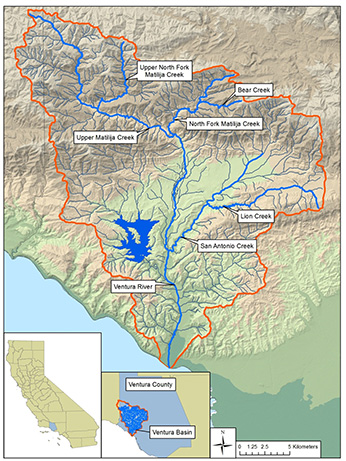 Figure 2. The Ventura River basin and monitored tributaries. (click/tap to enlarge)
Figure 2. The Ventura River basin and monitored tributaries. (click/tap to enlarge)
 Figure 3. Upper Matilija Creek, before (left, March-30-2015) and after (right, April-27-2015) a fish rescue conducted on April 1 2015. (CDFW photo) (click/tap to enlarge)
Figure 3. Upper Matilija Creek, before (left, March-30-2015) and after (right, April-27-2015) a fish rescue conducted on April 1 2015. (CDFW photo) (click/tap to enlarge)
Southern California steelhead trout (Oncorhynchus mykiss, Figure 1) population resilience after drought is an important aspect of their historical success. However, due to dramatic population declines and habitat loss, southern California steelhead trout were listed as federally endangered in 1997. The Ventura River watershed is listed as critical habitat and a high priority watershed for the recovery of steelhead trout. The California Department of Fish and Wildlife (CDFW) routinely monitors the mainstem of the Ventura River and its tributaries: Upper Matilija, North Fork Matilija, Upper North Fork Matilija, San Antonio, Bear, and Lion Creeks (Figure 2).
Need for Drought Stressor Monitoring
Little data on seasonal wet/dry conditions is available for the Ventura River watershed before 2013. The past several years of drought have reduced river flows to the point that many stream channels are becoming isolated pools or drying entirely (Figure 3). In stream reaches where flow has ceased due to the drought, dissolved oxygen has declined as riffles fail to add oxygen to the stream. Through routine monitoring of the Ventura River and its tributaries, CDFW can determine which areas dry first and also identify the best refuge habitats that remain wetted with suitable water quality.
Stressor Monitoring Efforts
To identify areas in danger of drying, and to find stranded steelhead trout, CDFW drought crews do walking surveys of stream reaches. During the winter and spring, field crews survey streams looking for spawning fish and redds. During the spring, summer, and fall, field crews monitor areas where habitat is drying and steelhead trout require relocation for survival. GPS units are used to record the beginning and end of wet and dry sections of each stream. The GPS data is used to generate maps to compare available habitat between seasons and across years. This monitoring data helps CDFW prioritize drought response in areas most likely to strand steelhead trout and to provide information on normal seasonal variability versus drought impacts.
Findings
Although wet/dry data for the Ventura watershed is still being collected and analyzed, inter-annual numbers from several tributaries are available for 2014 and 2015. Data for Upper Matilija Creek was collected between April and June of each year. In 2014, Upper Matilija Creek was 17% dry, and in 2015 it was 37% dry (Figure 4). For both Upper North Fork Matilija and North Fork Matilija creeks, wet/dry data was collected in August of 2014 and 2015. Upper North Fork Matilija Creek was 2% dry in 2014 and 15% dry in 2015 (Figure 5). Habitat surveys in 2014 indicate North Fork Matilija Creek was 12% dry and 4% dry in 2015 at the same time of year (Figure 6).
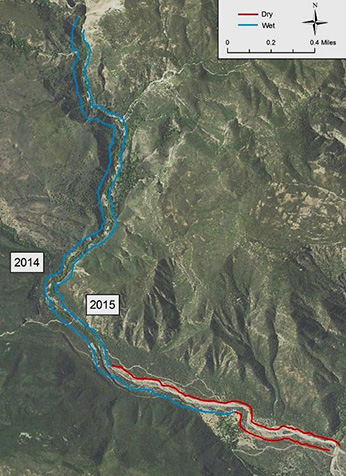 Figure 4. Upper Matilija Creek wet/dry data for 2014 and 2015. 2014 (left line) was 17% dry; in 2015 (right line) the creek was 37% dry. (click/tap to enlarge)
Figure 4. Upper Matilija Creek wet/dry data for 2014 and 2015. 2014 (left line) was 17% dry; in 2015 (right line) the creek was 37% dry. (click/tap to enlarge)
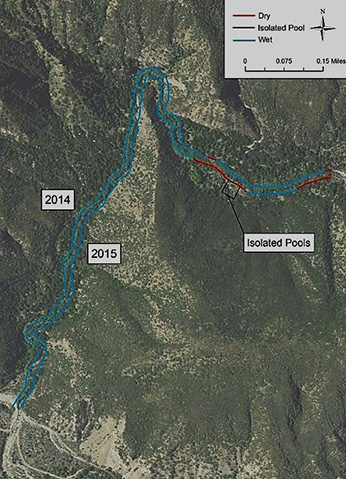 Figure 5. Upper North Fork Matilija Creek wet/dry between 2014 (left line) and 2015 (right line). Upper North Fork Matilija Creek was 2% dry in 2014 and 15% dry in 2015. (click/tap to enlarge)
Figure 5. Upper North Fork Matilija Creek wet/dry between 2014 (left line) and 2015 (right line). Upper North Fork Matilija Creek was 2% dry in 2014 and 15% dry in 2015. (click/tap to enlarge)
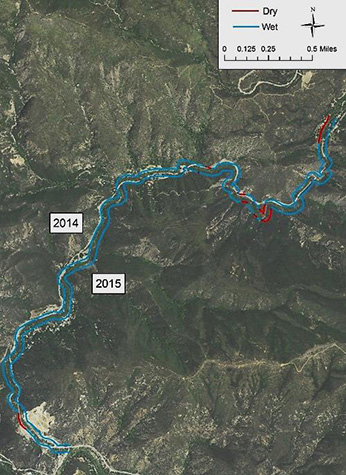 Figure 6. North Fork Matilija Creek wet/dry between 2014 (left line) and 2015 (right line). North Fork Matilija Creek was 12% dry in 2014 and 4% dry in 2015. (click/tap to enlarge)
Figure 6. North Fork Matilija Creek wet/dry between 2014 (left line) and 2015 (right line). North Fork Matilija Creek was 12% dry in 2014 and 4% dry in 2015. (click/tap to enlarge)
Many of the same locations that dried in 2014 also experienced drying in 2015. North Fork Matilija Creek was one of the few streams that became wetter.
Wet/dry surveys along San Antonio Creek performed by CDFW drought crews observed that severe drying occurred in 2014 and again in 2015 (Figure 7). Monitoring this creek became a priority because this creek is believed to be very important spawning habitat for returning anadromous adult steelhead trout. Unlike other tributaries, San Antonio Creek has no major barriers to fish passage, plenty of gravel for spawning, and a resident trout population in the lower portion of the creek, which could breed with returning anadromous adults. During a June 2015 snorkel survey, CDFW recorded 38 steelhead trout in a section of creek above Fraser Street near Ojai, CA.
These were the last known steelhead trout in San Antonio Creek. All other areas of this creek had dried or the water quality became too poor (low dissolved oxygen levels and high temperature) for fish survival. Although water quality in this creek section was stressful to fish (dissolved oxygen briefly dropped below 2 mg/l in early September), this was the best habitat remaining in San Antonio Creek during 2015 (Figure 8). By October, conditions improved with rising flow, increased dissolved oxygen levels, and decreased temperature.
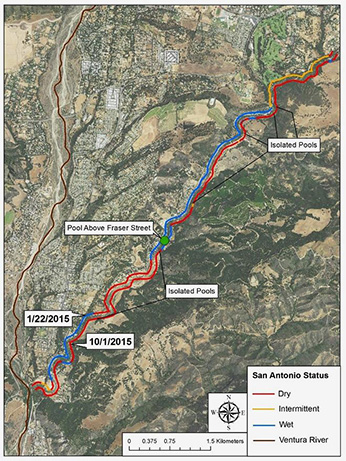 Figure 7. San Antonio Creek during 2015. In January (left line) it was 57% Wet, 19% intermittent (pools but no flow) and 24% dry. By the beginning of October (right line) it was only 6% wet, 21% intermittent and 73% dry.(click/tap to enlarge)
Figure 7. San Antonio Creek during 2015. In January (left line) it was 57% Wet, 19% intermittent (pools but no flow) and 24% dry. By the beginning of October (right line) it was only 6% wet, 21% intermittent and 73% dry.(click/tap to enlarge)
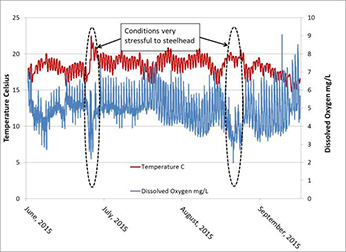 Figure 8. Temperature and dissolved oxygen in the section of San Antonio Creek above Fraser Street. (click/tap to enlarge)
Figure 8. Temperature and dissolved oxygen in the section of San Antonio Creek above Fraser Street. (click/tap to enlarge)
Future Efforts
Due to the lack of seasonal and inter-annual data available before the drought began in 2013, continuing the monitoring efforts of the CDFW drought crews will be beneficial in determining short-term (seasonal) and long-term (inter-annual) drying trends of the streams that are crucial for southern California steelhead trout survival. Understanding seasonal drying trends in both drought conditions and non-drought conditions will allow CDFW to make more informed decisions for managing California’s natural resources.
CDFW